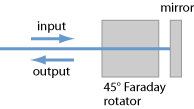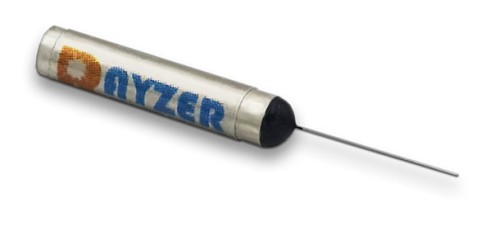Faraday mirrors (original) (raw)
Acronym: FRM
Definition: the combination of a Faraday rotator and a mirror
Alternative terms: Faraday rotator mirrors are reflectors where the polarization states of input and output are always orthogonal, at least within some wavelength range. They are available in bulk-optical and fiber-optic form.
Categories:  general optics,
general optics,  photonic devices
photonic devices
Related: Faraday rotatorspolarization of light
Page views in 12 months: 1173
DOI: 10.61835/jx4 Cite the article: BibTex BibLaTex plain textHTML Link to this page! LinkedIn
Content quality and neutrality are maintained according to our editorial policy.
📦 For purchasing Faraday rotator mirrors, use the RP Photonics Buyer's Guide — an expert-curated directory for finding all relevant suppliers, which also offers advanced purchasing assistance.
Contents
What is a Faraday Mirror?

A Faraday mirror (or Faraday rotator mirror) is made by combining a Faraday rotator (for 45° rotation) with a mirror. Light hitting such a reflector device will thus first pass through the Faraday rotator, then be reflected at the mirror, and finally pass the Faraday rotator a second time (see Fig. 1).
Assuming that the Faraday rotator applies a single-pass rotation by 45° (which can be approximately achieved within a limited wavelength range), the polarization state at the output will always be orthogonal to that at the input:
- If the initial polarization is linear, the output polarization will also be linear, but with an orthogonal direction: rotated twice by 45°, in total 90°.
- If the initial polarization is circular, the output polarization will be circular with the opposite sense of rotation. (In that situation, the same would occur even without the Faraday rotator.)
The major imperfection of those devices is a double-pass rotation which deviates from exactly 90°, apart from the insertion loss.
Application in Double-pass Configurations
Interestingly, the orthogonality between input and output polarization is still obtained when another optical element is added to the Faraday mirror, which may introduce birefringence with an arbitrary amount and birefringence axis. For example, that can be a laser crystal for amplifying the beam (see Figure 2). One then obtains a double-pass amplifier where the output can be separated from the input with a polarizer, accepting only a minimum amount of loss. This works better than using a Faraday isolator (with an output port for reflected light), an amplifier and an ordinary mirror, where birefringence in the amplifier may modify the polarization state such that some of the light will consequently be lost at the polarizer.

Figure 1: Setup of a double-pass laser amplifier. The Faraday mirror on the right side ensures that the polarization state of light is not distorted after a double pass through the amplifier medium.
Note, however, that the perfect polarization orthogonality may be lost if we have a substantial influence of diffraction in the optical setup. Therefore, one should work with collimated beams, having a low beam divergence. Nonlinear polarization rotation can also not be compensated.
Fiber-optic Faraday Mirrors
There are also Faraday mirrors in fiber optics, where the input and output light goes through an optical fiber — usually, a single-mode fiber. It can be a “fiber-optic pigtail”, but versions with a fiber connector (e.g. FC/PC or FC/APC) are also available.
Fiber-optic Faraday mirrors can exhibit a low insertion loss of well below 1 dB, although some devices exhibit higher losses of several decibels.
Another important specification is the precision of polarization rotation. Some devices achieve a rotation angle accuracy of e.g. 1° over a 30-nm wavelength range.
Fiber-optic Faraday mirrors are used for similar purposes as bulk-optic devices, often for exploiting the compensation of random birefringence in some length of passive or active fiber. Applications are in different fields of fiber optics, for example in optical fiber communications, fiber amplifiers, measurement technology with fiber interferometers and fiber-optic sensors.
Frequently Asked Questions
What is a Faraday mirror?
A Faraday mirror, or Faraday rotator mirror, is an optical device that combines a 45° Faraday rotator with a mirror. It is designed to reflect light with a polarization state that is precisely orthogonal to the incident light's polarization.
How does a Faraday mirror achieve a 90° polarization rotation?
Light first passes through the Faraday rotator, which rotates its polarization by 45°. After reflection from the mirror, the light passes through the rotator again, receiving another 45° rotation in the same direction, for a total of 90°.
What is a primary application of Faraday mirrors?
They are often used to compensate for polarization distortions caused by birefringence in optical elements. For example, in a double-pass amplifier, a Faraday mirror ensures that the output beam can be cleanly separated from the input beam with a polarizer, minimizing loss.
Are there fiber-optic versions of Faraday mirrors?
Yes, fiber-optic Faraday mirrors are widely used. They typically come with a fiber pigtail or a connector and are used in fiber amplifiers, sensors, and communication systems to cancel random birefringence in the optical fiber.
Suppliers
Sponsored content: The RP Photonics Buyer's Guide contains nine suppliers for Faraday rotator mirrors. Among them:
⚙ hardware
CSRAYZER offers a Faraday rotator mirror, which takes the output beam from a single-mode fiber and rotates the polarization by 90° before sending it back through the same fiber. It is used for eliminating polarization-induced fluctuations in fiber interferometers, Brillouin amplifiers, fiber lasers, fiber sensors, and fiber optic antenna remote systems. It has excellent optical performance, an ultra-small package size, high environmental adaptability and reliability.
⚙ hardware
DK Photonics offers polarization-maintaining Faraday mirrors for use in fiber-optic networks and measurement applications. It can help to eliminate the polarization sensitivity of optical fiber systems.
Questions and Comments from Users
Here you can submit questions and comments. As far as they get accepted by the author, they will appear above this paragraph together with the author’s answer. The author will decide on acceptance based on certain criteria. Essentially, the issue must be of sufficiently broad interest.
Please do not enter personal data here. (See also our privacy declaration.) If you wish to receive personal feedback or consultancy from the author, please contact him, e.g. via e-mail.
By submitting the information, you give your consent to the potential publication of your inputs on our website according to our rules. (If you later retract your consent, we will delete those inputs.) As your inputs are first reviewed by the author, they may be published with some delay.



